|
Rose Family: Rosaceae
Apples
Apples (Malus communis, M. pumila, & M. sylvestris), pears (Pyrus communis) and quince (Cydonia oblonga) belong to the rose family (Rosaceae), and include literally hundreds of cultivated varieties. In the apple, the original ancestral species is obscured by so many cultivated variations throughout the centuries that some authors lump them all into one species, Malus domestica. They all originated in western Asia (or Eurasia) and are characterized by fleshy fruits called pomes. In the pome, a thick, fleshy hypanthium layer (also called the floral cup or calyx tube) surrounds (and is fused with) the seed-bearing ovary or core. The sepals, petals and stamens arise from the rim of the hypanthium. Since the ovary is situated below the attachment of the sepals, petals and stamens, it is termed "inferior" in technical plant taxonomy books. The fleshy hypanthium of a rose (Rosa) surrounds a cluster of small one-seeded achenes. Since the achenes represent separate ripened ovaries all derived from a single flower, the entire structure (called a rose hip) can be considered an aggregate fruit or etaerio. Rose hips are eaten raw and are ground up as a supplemental source of vitamin C (ascorbic acid).
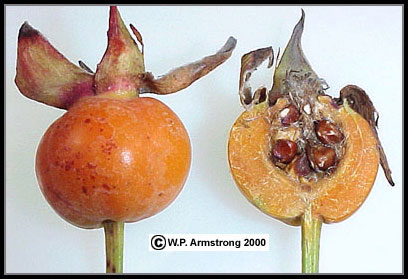
|
Rose hips from a hybrid tea rose (Rosa odorata). The actual seed-bearing achenes are surrounded by a thick, fleshy hypanthium. Since the achenes represent separate ripened ovaries all derived from a single flower, the entire rose hip could be considered an aggregate fruit or etaerio. In apples and pears, the thick, fleshy hypanthium is fused with the inner, seed-bearing core, and the fruit is termed a pome. Unlike most fleshy fruits, when you bite into an apple you are eating the hypanthium tisue rather than the ripened ovary or core.
|
The edible part of most fruits is the actual ovary, but in apples and pears only the outer hypanthium layer is eaten (unless you enjoy eating the core). Other members of the rose family that produce pomes are hawthorne (Crataegus), service berry (Amelanchier), Pyracantha, and California holly or toyon (Heteromeles), also listed under the genus Photinia. The name Hollywood, California is derived from the small, bright red, holly-like pomes of California holly (Heteromeles arbutifolia), a common native shrub in the hills where this city was established. California holly is not related to true holly (Ilex), a member of the holly family (Aquifoliaceae).

|
The fruits of California holly (Heteromeles arbutifolia) compared with a U.S. penny. They are tiny pomes that resemble miniature apples. Like true apples, the freshly-cut fruit readily becomes oxidized and turns yellowish-brown in the air. The actual mechanism for this blackening process involves the oxidation of phenolic compounds in the tissues by the enzyme tyrosinase. The resulting quinones rapidly polymerize into a brown residue. Placing freshly-cut pieces of apples under water prevents this "unsightly" oxidation. In fact, chefs add lemon juice, which contains the strong reducing agent ascorbic acid; this keeps the phenolics reduced.
|
Most of the apples grown commercially are diploid (2n), although there are many triploid varieties. For example, 'Gravenstein' apples are triploid with a chromosome number of 51 (3n=51). They are produced by the union of a diploid egg (2n=34) and a haploid sperm (n=17). This is accomplished by crossing a tetraploid plant (4n=68) with an ordinary diploid plant (2n=34). Because the triploid (3n) varieties are sterile, they must be propagated by grafting, where the scions of choice cultivars are grafted to hardy, pest-resistant root stalks.
Apples are mentioned throughout most of recorded human history. The generic name Malus is derived from the Latin word malus or bad, referring to Eve picking an apple in the Garden of Eden; however, some biblical scholars think the fig, and not the apple, was the forbidden fruit picked by Eve. One of the earliest records of any fruit eaten by people of the Middle East is the common fig (Ficus carica). Remnants of figs have been found in archeological excavations dating back to the Neolithic era, about 1000 years before Moses. The fig is also the first tree mentioned in the Bible in the story of Adam and Eve. There are some scholars who think the apricot is a more likely candidate because it was an abundant fruit (along with figs) in the ancient Palestine area. Other interesting tales about apples include Johnny Appleseed, William Tell, Sir Isaac Newton, and Apple Computers.

|
Assorted cultivars of apples (Malus domestica): A. 'Fuji,' B. 'Granny Smith,' C. 'Braeburn,' D. 'Red Delicious,' and E. 'McIntosh.'
|
Pears
Pears and quince also produce fruits called pomes. There have essentially the same structure as apples, except they contain numerous stone cells in their tissue. Stone cells (sclereids) are isodiametric cells (with equal diameters) and with very thick, sclerified cell walls. They appear like square cells with rounded off corners under high magnification (400 X). Stone cells are responsible for the gritty texture of pears and quince. Quince fruits have even more stone cells than pears and are used mostly for preserves and jellies.
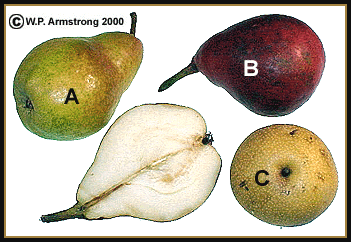
|
A. and B. Yellow and red 'Bartlett' pears (Pyrus communis); C. Asian pear (Pyrus pyrifolia).
|
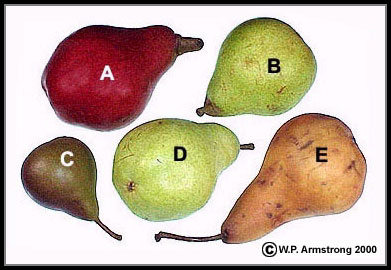
|
Varieties of the common pear (Pyrus communis): A. 'Red Bartlett,' B. 'Comice,' C. 'Seckel,' D. 'Bartlett,' and E. 'Bosc.'
|
Quince

|
The quince (Cydonia oblonga), a relative of the apple and pear. Like apples and pears the fruit is a pome, and the freshly-cut mesocarp quickly becomes oxidized and turns brown when exposed to the air. Quinces are commonly made into preserves and jellies.
|
|
Japanese flowering quince (Chaenomeles speciosa), a small tree or shrub in the rose family (Rosaceae) native to China. The fruits (pomes) are used for jellies and jams. Note: Jelly is a transparent spread of clear fruit juice boiled with sugar and pectin. Jam contains crushed fruit boiled with sugar.
|
Loquat
Another interesting pome in the rose family (Rosaceae) with a flavor reminescent of apples and pears is the loquat (Eriobotrya japonica). The loquat is a small evergreen tree with broad, prominently-veined leaves and fragrant white flowers. This species was once placed in the genus Photinia, along with California holly (Heteromeles arbutifolia). It is native to eastern China and Japan where it is commonly cultivated. It is also grown in California, Florida and the Gulf states. The fruit is eaten fresh and is made into jellies, pies and sauces.
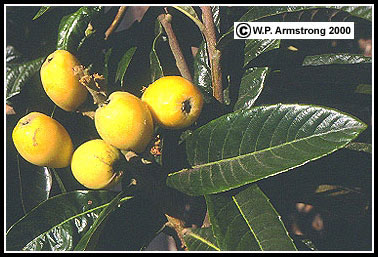
|
The pomes of loquat (Eriobotrya japonica) are similar to apples and pears.
|
There are many additional pome fruits from the rose family, including the medlar (Mesipulus germanica), a small deciduous tree native to Europe and Asia Minor. The ripe, apple-shaped fruits are eaten raw and used in preserves.
Stone Fruits Of The Genus Prunus
The rose family also includes many economically-important fruit trees known as stone fruits in the genus Prunus. Botanists have moved some of these species into separate genera, including Amygdalus (peach) and Armeniaca (apricot). Some examples of stone fruits are fuzzy-skinned peaches (P. persica syn. Amygdalus persica), smooth-skinned peaches called nectarines (another variety of P. persica), plums (P. domestica), apricots (P. armeniaca syn. Armeniaca vulgaris), and cherries (P. avium and P. cerasus). Like apples and pears, there are hundreds of cultivated varieties. These fruits are technically referred to as drupes because they consist of an outer skin or exocarp, a thick, fleshy middle layer or mesocarp, and a hard, woody layer (endocarp) surrounding the seed. The part of these fruits that is eaten by people is the mesocarp layer and also the exocarp if you don't bother to peel them. The woody endocarp layer protects the seed and probably aids in the dispersal of drupaceous fruits by hungry herbivores. In wild plants with drupes, the seeds can pass through the entire digestive system of grazing animals and be planted in new locations. The almond (Prunus amygdalus syn. Amygdalus communis) is also a drupe with a green exocarp and thin mesocarp surrounding the pit. When you crack open an almond to get the seed, you are actually cracking open the endocarp layer.
Pluot
Some species of Prunus have been artificially crossed to produce some unusual hybrids. The peachcot (Prunus persica x P. armeniaca) is a hybrid between the peach and apricot; the cherrycot (P. besseyi x P. armeniaca) is a hybrid between the cherry and apricot; the plumcot (P. domestica x P. armeniaca) is a hybrid between the plum and apricot. Some of these hybrids have many different named cultivars, depending on which varieties of stone fruits have been crossed together. In addition, hybrids often retain more characteristics of one parent and are given special names. For example, some cultivars of plumcots are called "pluots" because these resemble plums more than apricots. Plumcots called "apriums" resemble apricots more than plums.
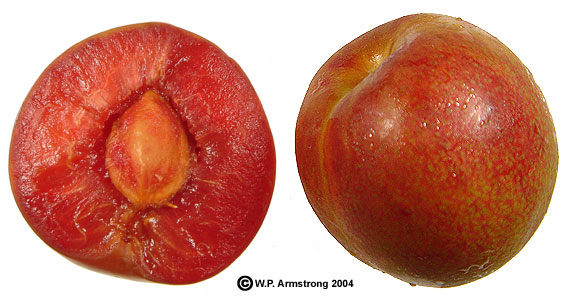
|
Plumcots, a delicious hybrid between the plum (Prunus domestica) and apricot (P. armeniaca). Since this cultivar resembles its plum parent more than its apricot parent, it is called a "pluot." Plumcot cultivars that resemble apricots more than plums are called "apriums."
|

Stone fruits of the genus Prunus typically contain poisonous hydrocyanic (prussic) acid (HCN) in the pits and foliage. Since the poisonous cyanide is combined with one or more sugars, these molecules are referred to as cyanogenetic glucosides. If you crush the leaves of a stone fruit tree, such as a cherry or apricot, you can smell the faint, almond-like odor of cyanide. The effects of hydrocyanic acid (cyanide) on the human body is disastrous because it inhibits the action of the vital enzyme cytochrome oxidase during cellular respiration. Without the oxidation of glucose, ATP production ceases. Therefore, HCN poisoning is essentially asphyxiation at the cellular level, because oxygen is not utilized at key steps in the Kreb's (citric acid) cycle. The cells thus die from lack of oxygen even though oxygen is plentiful in the blood. As little as 0.06 gram has caused death in some people. This is why it is considered unwise to dine on the seeds inside the pits of stone fruits. The exception appears to be almonds; however, some people feel that almonds should be consumed in moderation. The cyanogenetic glucoside found in the seeds of apricots, bitter almonds, cherries and plums is called amygdalin. It is used in the preparation of Laetrile, a highly controversial, alternative treatment for certain cancers.
Peach

|
A 'California' peach (Prunus persica), a freestone peach grown in California's fertile Central Valley. The fruit is called a drupe because it is composed of three distinct layers: An outer skin or exocarp (A), a fleshy middle layer or mesocarp (B), and a hard, woody layer (endocarp) surrounding the seed. The lower pit (removed from another peach) has been sectioned to show the thick, woody layer or endocarp (C) surrounding a single seed (D).
|

The pit of a peach (Prunus persica) showing the seed that is contained inside the hard, woody endocarp layer. The endocarp is the inner layer of the fruit wall or pericarp. It is surrounded by a fleshy mesocarp and a thin outer skin or exocarp. Fruits with a distinct endocarp layer surrounding the seed are called drupes. The endocarp protects and aids in the dispersal of the vulnerable seed, especially when it is swallowed by a hungry herbivore.
|
Almond
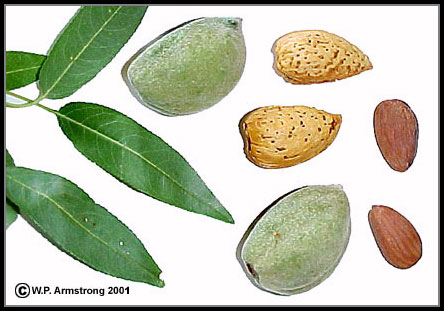
|
The fresh, greenish fruit of an almond (Prunus amygdalus) contains the familiar one-seeded endocarp (unshelled almond) that is commonly sold in supermarkets during the holiday season. Each hard-shelled endocarp contains a single seed.
|
Apricot

|
Apricot (Prunus armeniaca) showing fleshy drupe containng a hard, stony endocarp. The endocarp contains a single seed that is toxic because of high levels of cyanogenetic glucosides.
|
Cherries

|
Bing cherries (Prunus avium) showing the long stalk (pedicel) and fleshy drupe containng a hard, stony, seed-bearing endocarp. Sweet cherries such as these are usually considered to belong to P. avium, while sour cherries belong to the P. cerasus group. There are literally hundreds of varieties of cherries. Maraschino cherries are made from sweet cherries which have been bleached, deseeded, and soaked in a sugar solution to which red food coloring and flavoring have been added. Maraschino cherries are commonly covered with chocolate, placed as a decorative topping in ice cream sundies, and in mixed drinks.
|
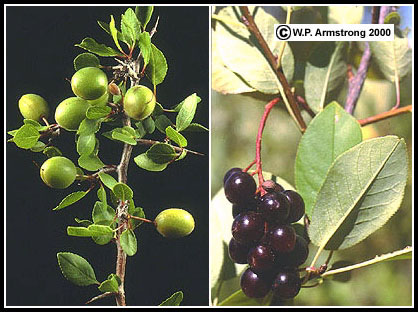
|
Two native stone fruits in San Diego County, California. Left: Desert Apricot (Prunus fremontii) in Anza-Borrego Desert; Right: Western Choke Cherry (Prunus virginiana var. demissa) on Palomar Mountain.
|
|
Holly-leaf cherry (Prunus ilicifolia ssp. ilicifolia), a native stone fruit in the chaparral of San Diego County. The Catalina Island Cherry endemic to Catalina Island is ssp. lyonii.
|

|
The mature drupes of bitter cherry (Prunus emarginata), from the slopes of Mount Shasta in Northern California.
|

|
Cherry pits in a clump of bear droppings near Flathead Lake, Montana. The hard endocarps pass through the bear's digestive tract, an adaptation that insures seed dispersal in some drupaceous species.
|
Buckthorn Family: Rhamnaceae
The buckthorn family (Rhamnaceae) is well-represented in the chaparral of California, including numerous species of California lilac (Ceanothus), coffeeberry (Rhamnus californica), redberry (Rhamnus crocea), and an interesting, spiny endemic shrub called adolphia (Adolphia californica). The potent laxative called cascara sagrada comes from the bark of Rhamnus purshiana, also native to California. An asian tree called jujube (Ziziphus jujuba) is cultivated for its small brownish or rust-colored fruits (technically called drupes) which superficially resemble olives in general shape and structure. The fruits are picked when they reach their typical rust color, but must be left to wither for some time until the pulp (mesocarp) becomes spongy and sweet. The fruits are soothing to sore throats and are used to flavor certain medicines. In Asia this is one of the trees inhabited by the lac insect, the excretions of which are the source of shellac. A native species of jujube (Z. parryi) occurs in the desert mountains of San Diego and Imperial Counties, California.

|
The ripe drupes of jujube (Ziziphus jujuba). This cultivar is called 'Li' and is only one of several pomological varieties.
|

|
The dried, datelike drupes of a jujube called annab (Ziziphus jujuba) for sale in a Middle Eastern market.
|

|
Desert jujube (Ziziphus parryi), a native species of this interesting genus in the Anza-Borrego Desert region of San Diego and Imperial Counties, southern California. Like the cultivated jujube, this spiny shrub produces small drupes. The drupes and foliage are often mistaken for another native shrub in this region called desert apricot (Prunus fremontii).
|
Olive Family: Oleaceae
Olive fruits are drupes produced by Olea europea, a Mediterranean tree commonly grown in California. Fresh olives are extremely bitter due to oleuropein, a phenolic glucoside. They are soaked in lye (sodium hydroxide) to remove (hydrolyze) the bitter oleuropein. Commercially grown olives are picked green and are oxidized in air (aerated) to produce the black color. The black color of canned olives is intensified and stabilized with ferrous gluconate. After the lye treatment, green olives are kept submerged to prevent oxidation in order to retain the green color. Pitted green olives are often stuffed with pimento, a bright red Capsicum pepper cultivar. Unlike most unsaturated plant oils which come from seeds, monounsaturated olive oil is obtained from the pulp or mesocarp of the fruit. Virgin olive oil is obtained from the 1st pressing.

|
Mature olive drupes (Olea europea), a Mediterranean tree commonly grown in California. A. Fresh olive at the picking stage. [To the lower right is a sectioned olive showing the stony endocarp (pit) surrounding the seed.] B. Fresh olive that is turning black on tree. C. Pitted, canned olive treated with ferrous gluconate. D. Pitted, canned green olive stuffed with pimento, a bright red Capsicum pepper cultivar. Fresh olives are soaked in lye (sodium hydroxide) to remove the bitter oleuropein. Commercially grown olives are picked green and are oxidized in air (aerated) to produce the black color. The black color of canned olives is stabilized with ferrous gluconate. Oxidation is prevented in green olives to preserve their color.
|
Laurel Family: Lauraceae
The avocado or alligator pear (Persea americana) is a member of the laurel family (Lauraceae), along with cinnamon (Cinnamomum zeylanicum), camphor (C. camphora), sassafras (Sassafras albidum), European bay (Laurus nobilis), and California bay or Oregon myrtle (Umbellularia californica). It is called an "alligator pear" because of the rough-skinned, pear-shaped fruits; however, true pears (Pyrus communis) belong to the rose family (Rosaceae). The nutritious, fleshy, berry-like fruit of the avocado contains a single large seed. It is not a drupe because the seed is not enclosed by a hard, woody endocarp layer, as in peaches and apricots. In fact, the dispersal of wild avocados by prehistoric animals remains an enigma because the vulnerable seed is relatively unprotected.
There are numerous cultivated varieties of avocados, but they are all derived from three main groups: The West Indian, Guatemalan and Mexican. West Indian cultivars have large, smooth, shiny-skinned fruits containing more water and less fat (monounsaturated oil) than the other groups. They are sometimes marketed as "lite" avocados with fewer calories. They are typically grown in warm, tropical climates, such as southern Florida and the Hawaiian Islands. The Guatemalan group was originally from the highlands of Guatemala. Cultivars in this group can be grown in more temperate climates than the West Indian group. A popular Guatemalan cultivar grown in southern California is the 'Hass,' easily recognizable by its thick, black, rough-skinned fruit. The Mexican group includes some of the hardiest and most commonly grown cultivars in southern California, including 'Duke,' 'Mexicola,' and 'Zutano.' One of the most important commercial avocados in California is 'Fuerte,' a Mexican x Guatemalan hybrid.

|
Avocado fruits (Persea americana): A. West Indian cultivar, B. Guatemalan cultivar ('Hass'), and C. Mexican x Guatemalan cultivar ('Fuerte'). There are numerous additional cultivars.
|
Mahogany Family: Meliaceae
Although not related to peaches, the little-known fruits called santol or kechapi (Sandoricum koetjape) actually smell like ripe peaches. They are produced by a Malaysian tree in the mahogany family (Meliaceae). This is probably the only commercially important fruit in the mahogany family.
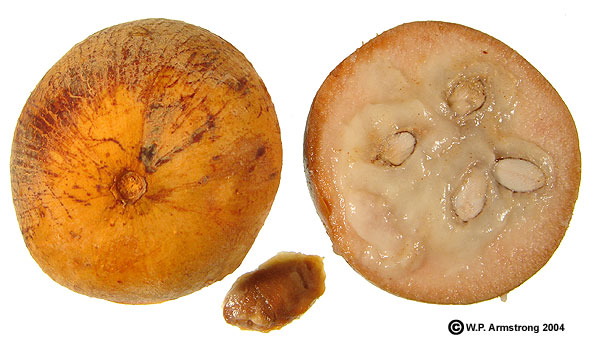
|
Ripe fruits of santol (Sandoricum koetjape), a Malaysian tree in the mahogany family (Meliaceae). The fruits have a firm rind and a white, translucent, juicy pulp that is firmly attached to the large seeds. The pulp is slightly acid and sweet. It is eaten fresh and made into jams, jellies and marmalade. Santol marmalade made in the Philippines is sometimes imported into the United States and sold in Asian markets. It is difficult to remove the pulp from the seeds, and there are reports of people swallowing the seed whole. This practice is hazardous to one's health because the seeds can stick together and cause serious intestinal blockage. There are reports of the sharp end of the seed piercing the intestinal wall.
|
|